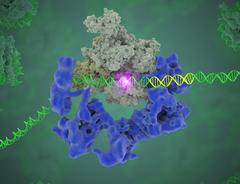
Active
View Entry | TFIID complex binds DNA to start gene transcription3766| Gene transcription is a process by which the genetic information encoded in DNA is transcribed into RNA. It's essential for all life and requires the activity of proteins, called transcription factors, that detect where in a DNA strand transcription should start. In eukaryotes (i.e., those that have a nucleus and mitochondria), a protein complex comprising 14 different proteins is responsible for sniffing out transcription start sites and starting the process. This complex, called TFIID, represents the core machinery to which an enzyme, named RNA polymerase, can bind to and read the DNA and transcribe it to RNA.
Scientists have used cryo-electron microscopy (cryo-EM) to visualize the TFIID-RNA polymerase-DNA complex in unprecedented detail. In this illustration, TFIID (blue) contacts the DNA and recruits the RNA polymerase (gray) for gene transcription. The start of the transcribed gene is shown with a flash of light.
To learn more about the research that has shed new light on gene transcription, see this news release from Berkeley Lab. Related to video 5730. | | Public Note | | | | | Internal Note | | Researchers gave permissions for public use:
Eva Nogales [enogales@lbl.gov]
Thursday, March 24, 2016 2:24 PM
Dear Martin,
This is great! We are delighted. I will be sending you a few, so that you can choose. We can also send you a video, if you want. Just let me know.
Can you let me know if these can be the same as in the publication (it will simplify things if I don't have to make new figures!)
Thanks,
Eva
Spiering, Martin (NIH/NIGMS) [C]
To:
enogales@lbl.gov
Thursday, March 24, 2016 11:40 AM
Dear Dr. Nogales,
I am a writer and editor with the Office of Communication and Public Liaison at the National Institute of General Medical Sciences. I am reaching out to you because we noticed your very striking image of the TFIID complex on DNA (see attached) in this recent news release (http://newscenter.lbl.gov/2016/03/23/unlocking-the-secrets-of-gene-expression/) describing your groundbreaking research advance on revealing the detailed structure of this complex. We would be very grateful if we could include your artwork in our Image Gallery on the NIGMS website (at https://images.nigms.nih.gov/).
Images and videos in the NIGMS Image Gallery highlight NIGMS-funded work and are made available to the public for educational uses, provided that users credit the creator, i.e., you, for this work. Would you let us feature your work in our image gallery in this way? If so, could you send me a high-resolution version of your image, if available? Please let me know if you have any questions.
I look forward to hearing from you.
Thank you,
Martin J Spiering, PhD, ELS
Writer & Editor (contractor)
OCPL, National Institutes of Health/NIGMS
martin.spiering@nih.gov | | | Keywords | | | | | Source | | Eva Nogales, Berkeley Lab | | | Date | | | | | Credit Line | | Eva Nogales, Berkeley Lab | | | Investigator | | Eva Nogales, Berkeley Lab | | | Record Type | | Illustration | | | Topic Area(s) | | ;#Genes;#Molecular Structures;#Tools and Techniques;# | | | Previous Uses | | | | | Status | | Active | |
| | View All Properties | | Edit Properties |
|
